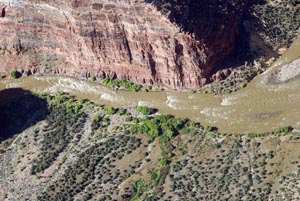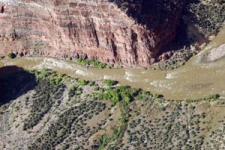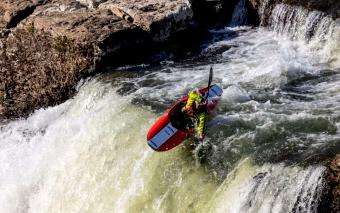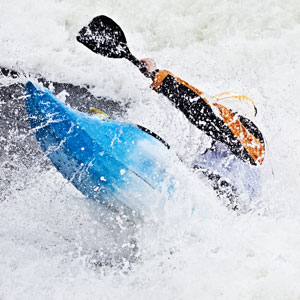[please login to make this ad block disappear]
Warm Springs Rapid on Yampa Rearranged
 Warm Springs Rapid on Yampa Rearranged
Warm Springs Rapid on Yampa Rearranged
What we surmise is that a small debris flow occurred near the top of the rapid, followed by a major rock fall from the Warm Springs Cliff.With its low water through much of the season, fewer paddlers than normal got to run Yampa Canyon in Colorados Dinosaur National Monument, and dodge the giant hole at the bottom of its signature Warms Springs rapid. Those who run it next year might want to give the rapid a second look while scouting. In early August, a flash flood, rock fall or both cascaded down the canyon, altering the landmark drop significantly.
"It'll be interesting next year," says Kelly Kager of the Dinosaur National Monument river office. "There might not be that duckpond anymore that people used to use to slow themselves down and avoid the Godzilla wave and Maytag hole." Heres the firsthand report from Peter Williams of Dinosaur National Monument, dated August 5, 2012... On August 3, 2012, Chris Dach and I arrived at Warm Springs Rapid on the Yampa River, on the third day of a low-water (roughly 150 cfs) inflatable kayak trip originating at Deerlodge Park. We stopped to inspect the rapid and discovered that some substantial changes in the rapids geography had recently occurred. Our first impression was that Warm Springs Draw had experienced a recent flash flood event, adding some new debris to the upper reach of the rapid. Wed seen evidence of recent flash floods in a number of drainages upstream, so it was no surprise to find such evidence here. But we quickly recognized that the relatively small flood event from Warm Springs Draw couldnt account for all of the devastationand the size of the new boulderson both sides of the river. Not only were many of the fresh boulders too large relative to the size of the new flash flood channel, they were all recently fractured into flat planes and sharp edges, indicating that they had not travelled any distance in a debris flow. We soon noticed that the several shattered box elders in the vicinity of the devastation were all arranged with their broken trunks and branches angled uphill away from the rapid, in the opposite direction of the flash flood waters. Many of the trunks of these trees were coated with up to a half inch of dried mudoften extending up to ten or twelve feet above the groundwith most of the mud caked on the sides facing the river. Many of the boulders in the rapid, both the older landmark features we were familiar with and the new additions, were coated with this mud layer, but typically only on vertical surfaces facing the center of what was clearly an impact zone. Mud was also splattered on rocks and trees up to a hundred feet or more from the impact zone. What we surmise is that a small debris flow occurred near the top of the rapid, followed by a major rock fall from the Warm Springs Cliff. The rock fall may or may not have occurred during the same weather event that created the flash flood, but there was no evidence of debris flow material deposited on top of the rock fall debris. An area of exfoliated rock surface is visible high on the Warm Springs Cliff directly above the impact zone, but we could discern no evidence of damage to the cliff wall below this scar, which made it difficult to be sure that this was the actual source of the rock fall. Neither of us felt confident that this feature was new, but we had no memory of it seeing it in the past. It is similar in appearance to the coke bottle scar that is so prominent high on the cliff wall when approaching the rapid from upstream, but is several hundred feet farther downstream of that landmark. Several details about this event continue to mystify us. The caked mud clearly extends up the trees along the edge of the rapid far too high to have been the result of pooling water from a temporarily dammed river. Clearly there must have been some minor damming of the river during these events, but we saw no evidence of new sediment and rock washed into the lower half of the rapid, a condition we would expect after a larger dam was subsequently breached. In addition, the mud deposits farthest from the impact zone often appear to have rained down on the top surfaces of the preexisting debris fan material, rather than having been deposited by flood waters. Yet the existence of large boulders with thick mud deposits only on a single vertical face, especially evident on the large boulder shown on page 1, suggests there was more to this dynamic than simply a rain of splashed mud after the impact. Perhaps the mud on the boulder in the photograph was originally accumulated in the fracture that eventually failed, creating the rock fall in the first place, and the clean faces of this boulder are the result of fracturing after impact. However, this would still leave unexplained the distinct, one-sided vertical coatings on several of the large boulders out in the rapid, most of which predate the rock fall. Another distinct feature is an apparent impact crater on the edge of the water, immediately upstream of the major rubble pile. We can understand no dynamic that would have created this deep, circular pit except perhaps that an extremely large block of rock landed here before bouncing out and shattering into the new rubble now piled next to the crater. The majority of the large, square-cut rock rubble is now piled on the river-right side of the rapid, just downstream of the point where boaters typically make their move to cut through the lateral waves at the top of the rapid. Even if next springs high water begins to settle and rearrange these boulders, it is likely that they will provide a new hazard to boaters making this crucial maneuverin the form of an new hole or, at the very least, by the addition of several very sharp rocks with the potential to cut boat tubes. The new accumulation of large rock presently creates a steep drop of approximately six to ten feet over a fifty- or sixty-foot section of the rapid. In past years at low water I have observed a similar short, steep drop in the river at this spot, but the gradient seems now to have been increased, with more pooling upstream. On the opposite side of the river there is now a large accumulation of smaller rock and fine debris, which is less likely to impact the rapid and will probably erode quickly in higher flows. This debris appears to me to have also been part of the rock fall, rather than a result of the flash flood down Warm Springs Draw. I believe the smaller material landed closer to the base of the cliff, while the larger blocks bounced away from the cliff during their descent. Small amounts of the same fine material occur on ledges several tens of feet above the main accumulation at river level, and small box elder on one of these ledges has been completely stripped of its leaves and branches. It will be interesting to see what the rapid looks like when next springs boating season begins, but boaters should be prepared to see some changes. |
Login to post here
















 Get for free:
Get for free:








